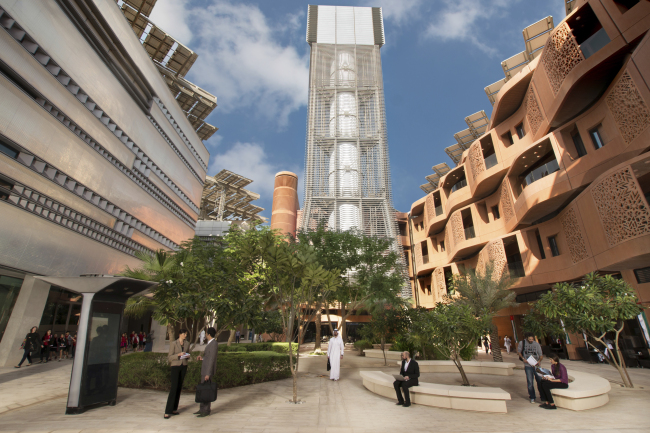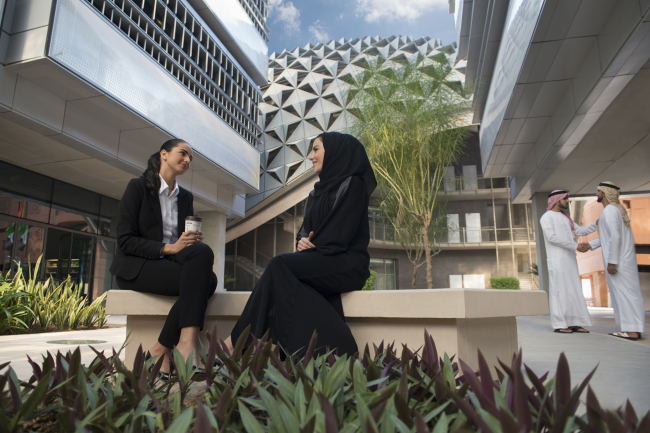ABU DHABI, United Arab Emirates -- Abu Dhabi, the capital of the United Arab Emirates, has long been a strategic business hub for foreigners with a zero-tax jurisdiction that offers 100 percent foreign ownership within free trade zones.
Along with such a business-friendly environment, the city is taking ambitious initiatives to turn itself into a sustainable urban city with various renewable energy development projects for its next generations, including the signature project of Masdar City.
Located in the heart of Abu Dhabi, 700-hectare Masdar City is gearing up to become a “greenprint” -- as opposed to a blueprint -- for how cities can accommodate rapid urbanization and sharply reduce energy, water and waste.
Along with such a business-friendly environment, the city is taking ambitious initiatives to turn itself into a sustainable urban city with various renewable energy development projects for its next generations, including the signature project of Masdar City.
Located in the heart of Abu Dhabi, 700-hectare Masdar City is gearing up to become a “greenprint” -- as opposed to a blueprint -- for how cities can accommodate rapid urbanization and sharply reduce energy, water and waste.

In 2008, renewable energy technology company Masdar, a subsidiary of the Mubalada Development Company, broke ground to build a sustainable urban development and economic free zone. The region encompasses commercial and residential buildings along with the Masdar Institute of Science and Technology, a not-for-profit private graduate university and research institute.
“Having a successful sustainable city on this hot and arid land suggests that such initiatives can be done in other countries even with challenging conditions,” Masdar CEO Ahmad Belhoul told The Korea Herald.
All elements of the city are aimed at reducing energy and water demand, as well as cutting embodied carbon.
All commercial and residential buildings are constructed with 90 percent recycled aluminum and low-carbon cement, along with other locally sourced and verified materials.
The walkways face away from the south with awnings and shade trees, while large Arabic cooling devices inspired by ancient Arabic techniques are installed at public spaces. The device is designed to capture the breeze and circulate it to provide cooler air.
An on-site 10-megawatt solar power plant provide a sustainable source of energy and produces 17,500 megawatt hours annually, thereby diverting 15,000 metric tons of carbon emissions per year. This is enough to power more than 1,000 homes, city officials explained.
The city is also preparing ways to make transportation green by developing a driverless, point-to-point, personal rapid transit and electric vehicle ride-share plan. Developing electric buses and a centralized low-carbon automated public transportation network are also under discussion, they said.

Currently, the city will eventually accommodate about 49,000 residents and 50,000 workers, with some 2,000 currently working. Once the city is fully built by 2030, it is expected to embrace a larger population, they added.
Starting with the Masdar Institute, a number of global organizations have already moved to Masdar City, including Siemens’ Middle East headquarters, General Electric and Mitsubishi Heavy Industries.
By Lee Hyun-jeong (rene@heraldcorp.com)
Korea Herald correspondent


![[AtoZ into Korean mind] Humor in Korea: Navigating the line between what's funny and not](http://res.heraldm.com/phpwas/restmb_idxmake.php?idx=644&simg=/content/image/2024/04/22/20240422050642_0.jpg&u=)
![[Exclusive] Korean military set to ban iPhones over 'security' concerns](http://res.heraldm.com/phpwas/restmb_idxmake.php?idx=644&simg=/content/image/2024/04/23/20240423050599_0.jpg&u=20240423183955)



![[Graphic News] 77% of young Koreans still financially dependent](http://res.heraldm.com/phpwas/restmb_idxmake.php?idx=644&simg=/content/image/2024/04/22/20240422050762_0.gif&u=)
![[Herald Interview] Why Toss invited hackers to penetrate its system](http://res.heraldm.com/phpwas/restmb_idxmake.php?idx=644&simg=/content/image/2024/04/22/20240422050569_0.jpg&u=20240422150649)





![[Exclusive] Korean military to ban iPhones over security issues](http://res.heraldm.com/phpwas/restmb_idxmake.php?idx=652&simg=/content/image/2024/04/23/20240423050599_0.jpg&u=20240423183955)



![[Today’s K-pop] Ateez confirms US tour details](http://res.heraldm.com/phpwas/restmb_idxmake.php?idx=642&simg=/content/image/2024/04/23/20240423050700_0.jpg&u=)